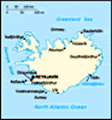Icelandic Economy, Iceland Economy
Advertisement
Economy - overview: Iceland's Scandinavian-type economy is basically capitalistic, yet with an extensive welfare system (including generous housing subsidies), low unemployment, and remarkably even distribution of income. In the absence of other natural resources (except for abundant geothermal power), the economy depends heavily on the fishing industry, which provides 70% of export earnings and employs 8% of the work force. The economy remains sensitive to declining fish stocks as well as to fluctuations in world prices for its main exports: fish and fish products, aluminum, and ferrosilicon. Government policies include reducing the budget and current account deficits, limiting foreign borrowing, containing inflation, revising agricultural and fishing policies, diversifying the economy, and privatizing state-owned industries. The government remains opposed to EU membership, primarily because of Icelanders' concern about losing control over their fishing resources. Iceland's economy has been diversifying into manufacturing and service industries in the last decade, and new developments in software production, biotechnology, and financial services are taking place. The tourism sector is also expanding, with the recent trends in ecotourism and whale watching. Growth had been remarkably steady in 1996-2001 at 3%-5%, but could not be sustained in 2002 in an environment of global recession. Growth resumed in 2003, and estimates call for strong growth until 2007, slowly dropping until the end of the decade.
GDP:
GDP - real growth rate: 1.8% (2004 est.)
GDP - per capita: Purchasing power parity - $31,900 (2004 est.)
GDP - composition by sector: Agriculture: 11.2% industry: 9.6% services: 79.2% (2004 est.)
Population below poverty line: NA%
Household income or consumption by percentage share: Lowest 10%: NA% highest 10%: NA%
Distribution of family income - Gini index:
Inflation rate (consumer prices):
Labor force: 158,100 (2004 est.)
Labor force - by occupation: Agriculture, fishing and fish processing 10.3%, industry 18.3%, services 71.4% (2003)
Unemployment rate: 3.1% (2004 est.)
Budget: Revenues: $4.154 billion expenditures: $4.058 billion, including capital expenditures of $467 million (2004 est.)
Industries: Fish processing; aluminum smelting, ferrosilicon production, geothermal power; tourism
Industrial production growth rate: 8.8% (2004 est.)
Electricity - production: 8.271 billion kWh (2002)
Electricity - production by source:
Electricity - consumption: 7.692 billion kWh (2002)
Electricity - exports: 0 kWh (2002)
Electricity - imports: 0 kWh (2002)
Oil - production: 0 bbl/day (2001 est.)
Oil - consumption: 16,300 bbl/day (2001 est.)
Oil - exports: 0 bbl/day (2001)
Oil - imports: 15,470 bbl/day (2001)
Oil - proved reserves:
Natural gas - production:
Natural gas - consumption:
Natural gas - exports:
Natural gas - imports:
Natural gas - proved reserves:
Agriculture - products: Potatoes, green vegetables, mutton, dairy products, fish
Exports: $2.902 billion f.o.b. (2004 est.)
Exports - commodities: Fish and fish products 70%, aluminum, animal products, ferrosilicon, diatomite
Exports - partners: UK 19.1%, Germany 17.2%, Netherlands 11.5%, US 9.8%, Spain 6.8%, Denmark 4.6% (2004)
Imports: $3.307 billion (2004 est.)
Imports - commodities: Machinery and equipment, petroleum products; foodstuffs, textiles
Imports - partners: Germany 12.3%, US 9.9%, Norway 9.7%, Denmark 7.9%, UK 7.2%, Sweden 6.7%, Netherlands 6% (2004)
Debt - external: $3.073 billion (2002)
Economic aid - recipient:
Currency:
Currency code:
Exchange rates: Icelandic kronur per US dollar - 70.192 (2004), 76.709 (2003), 91.662 (2002), 97.425 (2001), 78.616 (2000)
Fiscal year: Calendar year
Advertisement
The information here has been derived from Public Domain Sources such as the CIA World Factbook. No liability can be taken for any inaccuracies.
Tot: 0.02s; Tpl: 0.008s; cc: 3; qc: 2; dbt: 0.004s; 1; m:domysql w:travelblog (10.17.0.13); sld: 1;
; mem: 1.1mb

 Settled by Norwegian and Celtic (Scottish and Irish) immigrants during the late 9th and 10th centuries A.D., Iceland boasts the world's oldest functioning legislative assembly, the Althing, established in 930. Independent for over 300 years, Iceland ...
Settled by Norwegian and Celtic (Scottish and Irish) immigrants during the late 9th and 10th centuries A.D., Iceland boasts the world's oldest functioning legislative assembly, the Althing, established in 930. Independent for over 300 years, Iceland ...
